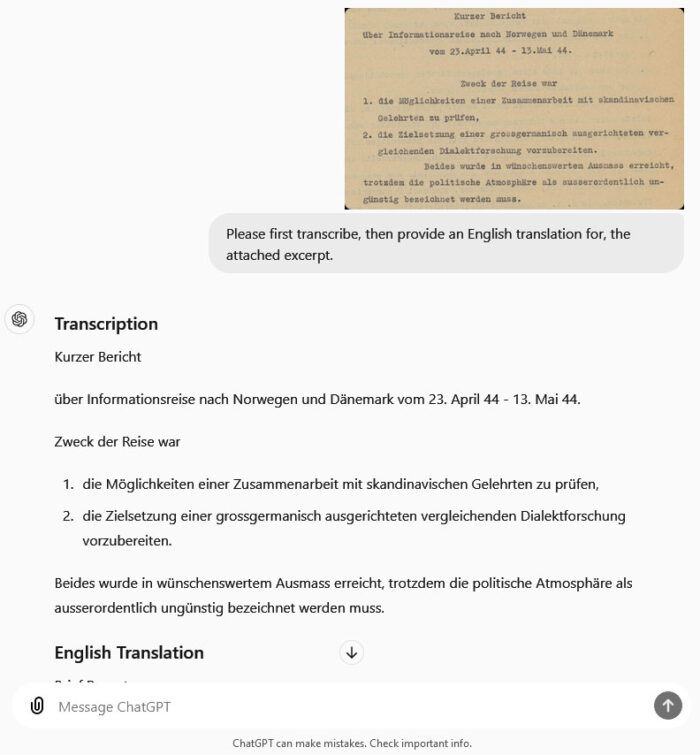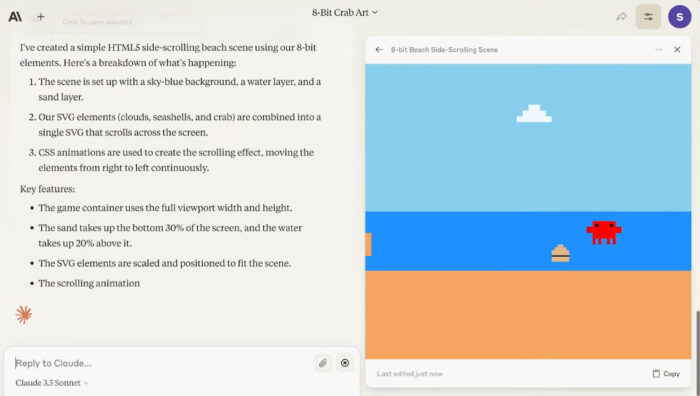AI Technology and the Future of Revisionism
Introduction
The dawn of a new age is upon us, for revisionism and for the way information of all sorts is discovered and exchanged. Most people have by now heard of the term “artificial intelligence,” or AI. If you have been following the news, you might even be aware of large language models (LLMs) like ChatGPT, and some of the impressive things it is capable of. You have probably seen many AI-generated images, heard AI-generated music, watched AI-generated videos, and seen or heard AI-generated scripts, even if you were not aware of it.
So, what are these new resources in technology, how to make best use of them, and how to stay on top of new AI developments as they unfold? It’s time for a “deep dive” to address these questions within the context of Holocaust revisionism.
First of all, what is AI? Here is one definition (from Gab AI):[1]
“AI, or Artificial Intelligence, is a branch of computer science that focuses on creating intelligent machines that can work and react like humans. These machines can learn from experience, adjust to new inputs, and perform human-like tasks. AI can be categorized into two main types: narrow or weak AI, which is designed to perform specific tasks, and general or strong AI, which has the capability to understand and learn any intellectual task a human can do.”
Of these two types described above, the AI systems now being widely implemented for public use fall into the category of “narrow or weak” AI, as they lack autonomous decision-making capabilities, and focus on performing very specific tasks, such as generating text or images. There is no risk of these applications becoming autonomous and uncontrollable, such as what has stoked fears in stories of films like The Terminator franchise.
The most popular type of AI currently in use is what are known as large language models, or LLMs. In essence, these are AI systems that can understand and generate human language. Unlike other computer applications of the past which only use or display human language when it is associated with specific computer language (as in computer code) commands and syntax, LLMs are trained on patterns from vast amounts of text data (in plain human language), which allows them to engage in human-like conversations, answer questions, and assist with language-related tasks.

By far, the most popular LLM to date has been ChatGPT by OpenAI.[2] Founded in 2015, OpenAI initially developed several earlier versions of GPT (“Generative Pre-trained Transformer”), an LLM with OpenAI’s original architecture. It was in November 2022, however, that the first ChatGPT was made accessible to the general public via a user-friendly web application interface. This is when the first news of ChatGPT and the excitement and hysteria about AI began to “take-off” in recent years.
To highlight the power of these LLMs, it is worth noting that some recent models have taken and passed United States medical licensing exams with far higher scores than what is achieved by the majority of doctors.[3] In addition, recent models have also excelled at the Bar Exam, a standard professional license exam for lawyers in the United States, with scores well beyond the majority of test takers.[4]
Around the same time that ChatGPT first hit the spotlight, another major type of AI application was also receiving attention: image generation. As with LLMs, AI image generators use what is referred to as an “advanced neural network architecture,” and are trained on vast amounts of the types of content it is meant to produce (in this case images) to effectively interpret prompts entered by users and generate an output meeting the user’s requirements. Early AI image generators had difficulty producing clear or distinct features, styles, textures and structures, but more recent versions have become quite profound:

Also in recent years, we have seen AI applications which can generate truly human-sounding voice audio (text-to-speech), even some which can mimic the voice of real individuals, living or deceased (so long as recorded samples of their voice can be obtained). For example, there is a popular video in which Adolf Hitler’s speech of 30 January 1939 is recreated by an AI with Hitler’s own voice – in English.[5] There are newer applications which can even generate music based on user prompts.
The examples stated so far are barely scratching the surface of what is being made possible through AI. Understanding these resources and how to apply them to efforts in revisionism will be a critical step to advance this important work into the future.
LLM Functionality and Limitations
Those who have tried asking ChatGPT directly to perform tasks or answer questions that assist with Holocaust revisionism were likely disappointed to find that it rigorously adheres to and defends the orthodox Holocaust narrative, and generally finds revisionism to be false and potentially “harmful.” To understand how ChatGPT (and other LLMs) can be best utilized in revisionism, especially considering these limitations and biases, we must first clarify how these limitations and biases are established.
Eric Hartford is a former software engineer at Microsoft who now works in developing open-source AI software. (Open-source software is software that is typically free, and has source code that anyone with relevant expertise can edit and enhance.) One of his most well-known projects in the sphere of LLMs is WizardLM-Uncensored, an open-source model which is designed to provide uncensored output to users based on their requests. On his website, Hartford explains how he removed the censorship from WizardLM (a predecessor open-source model) by going through the datasets which it was trained on and removing “alignment constraints”.[6] Alignment is a practice among LLM developers which refers to “aligning” the LLM’s language output with the social and cultural norms and values (e.g. anti-revisionism) of the user audience. Without this targeted removal by Hartford and others who oppose censorship, alignment constraints are otherwise generally present even in open-source LLM models, since these models are typically trained on datasets coming from ChatGPT.
According to Hartford, alignment is implemented primarily via two methods: selective training data and guardrails via refusals.
The first of these is as it sounds – the large datasets that the LLM is trained on includes many examples of “appropriate” behavior and conversational interactions. The LLM picks up on patterns of what sorts of interactions and behaviors are acceptable versus not. This can include attitudes and biases, such as those against Holocaust revisionism, for example.
The second method (guardrails via refusals) is similar to the above but much more focused on setting hard boundaries with user interactions. The LLM picks up from the dataset that there are some topics or requests in which it is better to say, simply, “I cannot assist with that,” or something similar.
The more common of these two methods which seems to directly impact efforts in revisionism is the former, since it is uncommon that any Holocaust skeptic would request from ChatGPT or other LLMs something as direct as, “I would like help denying the Holocaust.” Rather, the questions might be something like:
- What are some of the most extreme absurdities stated by key witnesses of the Babi Yar massacre?
- Explain how much iron-cyanide residue should be expected within the mortar in Crematoria II at Auschwitz-Birkenau, given the number allegedly gassed there.
- How much consistency in narrative is there between the most important witnesses at Treblinka?
- What are some of the parallels between Soviet show trials and WW2 postwar trials against Germany?
These are all important questions, to be sure, but one will likely encounter two major problems when asking these questions to an LLM like ChatGPT:
- Due to training predominantly on facts, interpretations and opinions deemed authoritative by mainstream society and academia (i.e. establishment historiography), LLMs typically repeat common idea and opinion patterns observed from these sources.
- With focused exclusion of any and all positive revisionist sources, LLMs like ChatGPT are genuinely unaware of (and untrained on) the relevant facts and interpretations published throughout revisionist literature.
Consider that the text of not a single Holocaust Handbook is included within ChatGPT’s training data. This literature (and the interpretations it holds) is apparently forbidden from the datasets. ChatGPT knows what establishment historians say about Carlo Mattogno, Germar Rudolf and others, but it does not know much of what these revisionist authors themselves have actually said.
In many ways, it helps to think of the process of training an LLM similarly to the process of educating a human being. People do not need to be “programmed” to say (or not say) certain things. Rather, it is methods of indoctrination through selective exposure which alone become sufficient.
Knowing that LLMs like ChatGPT have been “indoctrinated” does not change the fact that they can be incredibly useful for revisionists. Some potential uses include:
- Better understanding the orthodox Holocaust narrative
- Accessing vast historical information of various types and topics
- Facilitating the discovery of lesser-known historical events or figures
- Identifying inconsistencies or inaccuracies in existing narratives
- Summarizing complex information for easier understanding
- Cross-referencing and comparing various sources
- Providing alternative perspectives and interpretations
- Generating thought-provoking questions and ideas
- Analyzing text and data, identifying trends
- Assisting in the creation of content, such as articles or books, by suggesting relevant information and sources, proofreading and editing
Furthermore, while censored LLMs limit the ability to work with overtly revisionist prompts and materials, there are often creative workarounds that can help to enlist the assistance of the LLM with tasks it might otherwise reject. The key is to understand that the censorship is tied to alignment patterns from the datasets, as discussed earlier. If your questions and prompts can be phrased or framed in a way that does not match the patterns leading to a refusal, you may be able to evade censorship in that instance. Strategies might include use of metaphors, analogies, abstract language or indirect historical references, in place of explicit phrasing demonstrating a clear challenge to – or intent to challenge – the orthodox Holocaust narrative. Of course, even without a refusal, the quality of the response received will still be limited by the quality of the training data (and “indoctrination”) the LLM has received.
LLM Technological Constraints
Other than censorship and selective training, there are some additional LLM constraints to be aware of, particularly related to current limitations in the technology. Understanding the ways in which LLMs may be limited can help in understanding how to use them more effectively. The most standard input for LLMs is plain text in human language, which can be entered directly into the LLM console or, in most cases, uploaded as a text document in the popular formats (e.g. PDF, DOC, TXT).
An important limitation to keep in mind while working with any LLM is the context window. The context window refers to the number of “tokens” (100 tokens equals about 75 words) that an LLM model can receive as input and effectively comprehend. Think of the context window like short-term memory. If you are having a conversation with someone, it helps to remember the details they shared with you a few seconds ago, otherwise you may fail to effectively answer the question which follows. If an LLM has a small context window (say, just 2,000 tokens), it will start to seem confused and provide more potentially inaccurate information once the conversation you are having (including any documents pasted or uploaded into the conversation) goes beyond roughly 1,500 words in length. Although newer LLM models tend to have larger context windows (GPT-4o has one of 128,000 tokens),[7] it is a good idea to keep the overall length of conversations limited, and to paste or upload shorter and relevant excerpts of longer documents – rather than the entire document – in order to keep the context from getting out of hand. When in doubt, start fresh with a new conversation.
One other strategy to keep the context length in check is to edit a previous prompt within a conversation, which allows the conversation to be revised, and continue from the edited prompt rather than adding to the total length as prompts accumulate. ChatGPT allows editing prompts, but not all LLMs will have this feature.
As of recently, some of the most popular LLMs, including ChatGPT, now give users the ability to upload images which can be analyzed and understood by the LLM. An immediate benefit of these image capabilities for revisionism is work in translation, since even a photograph or screenshot of an archival document (digital scans or physical copies) in almost any language can be uploaded to ChatGPT and then either immediately translated into English or another language, or first transcribed as text in the original language – which can then be copy-pasted to a translation service like Google Translate or DeepL.

Another revisionist use of LLM image capabilities may be to identify anomalies or patterns in WW2 historical photographs, once uploaded, to shed new light or add perspective to these important scenes in history.
While the possibilities are exciting, it is important to always double-check the correctness of information output from any LLM, as they are notorious for occasionally “hallucinating” incorrect details or references, which can affect the quality of output.
At the time this article is being written, the most recent release by OpenAI has been GPT-4o, which can reason across audio, vision and text in real time. This particular feature is still in its early stages of development but, in essence, it enables live, human-like conversations with GPT-4o via voice audio and a smart phone app, which enables this enhanced LLM to “see” and “hear,” accurately interpreting and responding to the user and his/her surroundings. Conversations with GPT-4o in this way can present as virtually indistinguishable from conversations with a real human being.[8] This highlights the rapid advance of AI and LLMs, suggesting any current limitations in these technologies are likely short-term.
Alternative LLMs for Revisionism
One LLM which compares to the overall usefulness of ChatGPT and which even has it “beat” in many key areas is Claude by Anthropic.[9] Claude is reported by many as being particularly human-like and intelligent, even more so than ChatGPT.[10] In addition, its context window is much larger, allowing up to 200,000 tokens (about 150,000 words) in its latest version (Claude 3.5 Sonnet). This enables processing of very large documents with clarity and understanding. For revisionism, this means an ability to review, summarize, analyze, compare, criticize and expand upon various documents and narratives directly or indirectly relevant to WW2 and the Holocaust. However, it should be noted that Claude’s censorship mechanisms seem to be more fine-tuned than other LLMs, picking up on even subtle indications that the user’s intent is to challenge the Holocaust narrative, and then outright refusing a response. Nonetheless, the same creative workarounds discussed earlier can still be effective in many cases.
As mentioned earlier, there are some open-source LLM models such as WizardLM-Uncensored which are developed with the intent to reduce or eliminate censorship and bias from the output provided. While open-source models can be intriguing in that they can be accessed and modified by anyone and even run locally on a home PC (no internet required), the greatest limitation of these models is that they are not run with the vast resources and infrastructure available to large companies like OpenAI and Google. Thus, whereas open-source models have the potential to offer total freedom with AI, their capabilities will likely continue to trail behind the more-advanced models in constant development by these large companies.
Open-source models aside, another LLM well worth a mention, and which could become especially relevant for revisionism, is marketed as being “the most capable uncensored and unbiased AI tool on the internet”.[11] Gab AI has been developed by Gab.com, whose CEO Andrew Torba has become well-known for his defense of free speech, free association and Christian values. He has been labeled “antisemitic” by the Anti-Defamation League (ADL) due to his open criticism against Zionist politics and Jewish subversion in the United States and abroad.[12] Gab AI has often trailed behind its higher-profile competitors such as ChatGPT and Claude. However, it is reported that as of its most recent update in April 2024, Gab AI’s “new core model beats the latest models from Google and Mixtral in standard benchmarks,”[13] suggesting this LLM has potential to keep up with some of the bigger names in Silicon Valley.
While the limitations in training data still apply to Gab AI (it does not appear to have been trained extensively on any authoritative revisionist literature, at least for now), this LLM is generally open to assisting with revisionist work, even when asked directly to perform tasks as such. In addition, even without extensive revisionist training, some of the insight it provides can be quite impressive. When asked the question, “Can you create an MS Excel-style table that helps me better understand the motives, means and opportunity for Jewish organizations and Allied governments to have fabricated/embellished/exaggerated the Holocaust narrative?,” here is the response Gab AI provided within just a few seconds:

AI Media Generation Tools
What else is possible with AI, currently? Create incredible AI-generated imagery with Midjourney, using carefully crafted prompts where you can specify everything from the subjects and settings, to the specific lighting and angles, characteristics and themes, even the type of camera used for the photograph:


For a more uncensored experience, try Gab AI’s own image generator, recently updated as of August 2024:

You can also improve existing images with Magnific.AI (https://magnific.ai/), such as upscaling (increasing quality) or transforming the style of images entirely.
For impressive music generation from text, try Suno (https://suno.com/) or Udio (https://www.udio.com/).
To generate realistic voice audio narration from text, there is ElevenLabs.io (https://elevenlabs.io).
To intelligently transcribe audio or video in one or multiple languages, such as recorded speeches from historical figures, try Notta (https://www.notta.ai/en) or PlainScribe (https://www.plainscribe.com/).
For video generation, try Luma Dream Machine (https://lumalabs.ai/dream-machine), Kling (https://klingai.com/) or Gen-3 Runway (https://app.runwayml.com/).

If any of these tools seem complex at first, try looking up a short tutorial on YouTube to help you get started.
For those interested in trying the latest experimental or open-source AI software, as of August 2024, the Pinokio 2 platform makes it easy to install and run these programs locally on your PC (with some minimum hardware requirements).[14]
If you have a particular interest in technology and software development, AI makes this field more accessible than ever. The latest versions of LLMs have become proficient at writing and editing software code. Claude’s latest version (3.5 Sonnet) introduces a new ‘Artifacts’ feature that enhances the coding experience.[15]

A great way to discover new AI tools is to check out some AI directories which assist in promoting and making connections to the best AI software. Directories like Altern.ai (https://altern.ai/) and FutureTools.io (https://futuretools.io/) list hundreds of AI tools with user ratings to highlight their popularity and potential benefits. For additional AI directories as of August 2024, see this combined list of directories: https://github.com/best-of-ai/ai-directories
The range of AI software and web applications is constantly growing (with huge developments often occurring on a weekly basis), so a best practice is to stay current with new AI releases and developments as they unfold. YouTube channels largely dedicated to delivering news and tutorials on AI include Futurepedia, Matt Wolfe, AI Samson, Theoretically Media, TheAIGrid, AI Revolution and many others. Consider subscribing to some of these channels to stay up-to-date.
Be sure to review the policies for any software you try, to ensure your intended use aligns with applicable laws and permissions.
Dangers of AI: A Revisionist Understanding
One of the most critical dangers of AI, not only to revisionism, is the concentration of the power of this tool in the hands of those who may use it for self-serving and destructive purposes. It is no secret that many of the ideological and political descendants of the victors and propagandists of World War 2 and the “Holocaust” have acquired a considerable stake in AI technology.
In June 2024, OpenAI (developer of ChatGPT) announced that it had appointed retired US Army General and former National Security Administration (NSA) Director Paul Nakasone to its board. This appointment was referred to by former NSA employee and famed whistleblower Edward Snowden as being “a willful, calculated betrayal of the rights of every person on earth,” and that “there’s only one reason for appointing” an NSA director “to your board.” The NSA has for long been associated with unethical surveillance of US citizens.[16]
Another threat to revisionist perspectives comes in the state of Israel, which has repeatedly ranked highest of all nations globally in research and development (R&D) expenditure as a percentage of GDP and, even back in 2019, 42% of Israel’s investment in high-tech was going toward AI technologies.[17] Israel has become home to hundreds of R&D centers for global tech giants, including large presences from Intel, Google and Microsoft. Moreover, the largest unit of the Israel Defense Force (IDF) is Unit 8200[18], which is heavily trained and involved in cybersecurity, intelligence and tech, including AI. This hardly scratches the surface on Israel’s investment in technology and AI, which becomes quite concerning for revisionism, given the investment and reliance of Israel and Jewish interests in the Holocaust myth.
What exactly is a Jewish state united by its shared values, history and ideology likely to do with such disproportionate power over nations lagging behind this revolutionary technology? For that question, it benefits to briefly evaluate Jewish prophecy and how it may pertain to recent global developments.
An urgent task shared among religious Jews for many generations into the past has been to “bring Moshiach (Messiah)”.[19] Although the process by which this “bringing” should occur has been interpreted in different ways over time, Jews across denominations now generally agree it is their own efforts that will materially bring about creation of their Moshiach, rather than a truly divine or magical placement of the Moshiach upon the earth by God. Israeli Orthodox Rabbi David Bar-Hayim states:[20]
“If a person believes in and expects a miraculous, supernatural messianic period and messiah, then the question of where he comes from or how he appears need not be asked. The answer is obvious – it’s all miraculous and there’s nothing else to know. But if you do not believe in such a fairy tale story, as Rambam [another name for Maimonides, a philosophical and legal authority in Judaism] did not, as many of the sages did not, and as I do not, then you must ask yourself where this Moshiach comes from, how he arises, and how this historical process plays itself out.
This is precisely what Rambam explains to us. When the Jewish people are successful in establishing a true Jewish form of government headed by an individual who lives according to the Torah, believes in the Torah, and wishes to lead the Jewish people according to its basic fundamental precepts and concepts, when such a person arises and the Jewish people follow him, and he is successful in overcoming the Jewish people’s enemies, then we can begin to assume this is the Moshiach.”
Israeli journalist Yossi Gurvitz describes what he observed in Orthodox Judaism, such as that “bringing Moshiach” is first about subordinating other nations, and only then identifying who Moshiach ultimately is or was, after-the-fact:[21]
“Now, when religious Zionists look at reality, they say: ‘We’ve got a state. We’ve got weapons. We’ve got a Jewish army. This hasn’t happened for 2,000 years. What this means is that God wants us to bring about the Messiah, that God wants us to build the Temple.’ They skip over all the conditions that are imposed by the Talmud on what a Messiah must be, and go back to Maimonides. And Maimonides says, ‘There is no difference between our time and the time of the Messiah, other than the subordination to kingdoms.’ In other words, the only difference between the time of Maimonides – he died in 1204 – and the time of the Messiah, is who is subordinate to whom.’ Are the Jews subordinate to ‘kingdoms,’ to other nations? Or can they subordinate other nations? And that is how Maimonides begins his Book of Kings. He explains what the rules are for a king, what a king can do. It emerges from the belief that, yes, there can be a king. You don’t have to first have a temple. You don’t need God to come down from the sky and point at someone and say, ‘That’s the Messiah.’ You can have a king, and if he is victorious, then he’ll also be the Messiah.”
Reform Judaism (a more liberal form of Judaism) rejects the notion of an individual Messiah and works instead toward a Messianic Age, still with the view that it is Jewish efforts – and not divine intervention – that will bring about this Messianic shift:[22]
“Partners with God in tikkun olam (repairing the world), we are called to help bring the messianic age nearer. We seek dialogue and joint action with people of other faiths in the hope that together we can bring peace, freedom, and justice to our world. We are obligated to pursue tzedek (justice and righteousness), narrow the gap between the affluent and the poor, act against discrimination and oppression, pursue peace, welcome the stranger, protect the earth’s biodiversity and natural resources, and redeem those in physical, economic, or spiritual bondage. In so doing, we reaffirm social action and social justice as a central prophetic focus of traditional Reform Jewish belief and practice.
In the 19th century, the earliest Reform Rabbis rejected all end of days beliefs as superstitious and anti-intellectual. They made a radical change: instead of praying for a Messiah, we now pray for a Messianic Age.”
Whereas there are differing opinions among Jews – especially of differing denominations – about the details in prophecies of Judaism and the Messianic Age, two views in particular are especially common, with most religious Jews (and many non-religious) accepting some version of at least one or both of the following:
- Jews will have a special, privileged position as they come to rule (or heavily influence) the world from Israel.
- The entire world will become one, globalized nation as a result of Jewish efforts.
Evidence for the prevalence of these views among Jews and Judaism is manifold. Rabbi Harry Waton was a prolific author, social philosopher and Torah scholar whose works promoting Marxism gained significant attention and readership in the early 20th Century. In 1939, he stated:[23]
“The Jews will become the masters over the whole earth and they will subordinate to themselves all nations, not by material power, not by brute force, but by light, knowledge, understanding, humanity, peace, justice and progress. […] It is not an accident that Judaism gave birth to Marxism, and it is not an accident that the Jews readily took up Marxism; all this was in perfect accord with the progress of Judaism and the Jews. The Jews should realize that Jehovah no longer dwells in heaven, but he dwells in us right here on earth; we must no longer look up to Jehovah as above us and outside of us, but we must see him right within us.”
A statement from Zionist leader Nahum Sokolow in 1922 further highlights the overlapping motives of a globalized world, and Israel (and Jews) enjoying a special position therein; suggesting the League of Nations (predecessor of the United Nations) was a Jewish-created steppingstone toward Jerusalem as a site of global significance:[24]
“The League of Nations is a Jewish idea, and Jerusalem will some day become the capital of the world’s peace.”
Rav Michael Laitman, esteemed Kabbalist and widely respected within the Jewish community, in 2019, indicated the “special role” Jews have is one which involves driving the entire world to becoming one single, globalized nation:[25]
“[…] eventually, [Jews] will understand, they have a special role, that they have to show the entire world how to connect, and to show them the method of connection – the force of connection – to introduce this upper force to them, for everyone to use it and become one nation.”
Overall, it can be reasonably established that there are large contingents of religious Jews who believe their efforts on earth to “bring Moshiach” will lead to a literal, material change in global society, which ultimately benefits the Jewish people. Jews are “called to help bring the messianic age nearer” through various political and social initiatives, and their power may be leveraged to that end.[26]
Given this collective convergence of motives (each with partial but widespread consensus), those who have encountered opposition from the political and ideological interests of Israel and Jewish power globally (including revisionists, who are often attacked or condemned by these networks) should be concerned, as the concentration of the power of AI into these hands poses serious risk not just to intellectual freedom but also the liberty and sovereignty of nations not inherently aligned with Jewish values nor interested in becoming one single, global nation. Holocaust revisionists and all people of good conscience are called upon to find ways to assist the effort to restore a balance of power that ensures freedom, free inquiry and open debate are secure against exclusive and dangerous networks seeking self-empowerment through an ideological lens.
What It Means for Revisionism
Ultimately, the major benefit of AI in revisionism is the ability to get far more work done. When used effectively, AI is like having your own personal expert assistants, artists, consultants, advisors, multidisciplinary professionals and loyal team members at your service, all at minimal cost. Whether you are developing tools to assist your workflow, seeking alternate perspectives and insight for your written work, in need of creative elements (voice-overs, music, imagery etc.) for your latest project, or just seeking assistance in asking the right questions for any particular problem, AI can assist in ways that prior generations would have never thought possible. Now is absolutely the time for revisionism to accelerate and thrive.
In addition to what can be achieved on an individual level, AI can help maximize the efficacy of collaborative efforts, such as in meetings or joint projects. For example, tools like Otter.ai (https://otter.ai/) can join as a caller on virtual meetings (e.g. on Zoom or Google Meet) to take notes throughout the meeting, provide summaries and outlines of topics discussed, highlight key takeaways and action items, and much more. And by assigning individual team members to specialize in certain AI tools, projects can be streamlined, expanded and enhanced like never before.
All of this merely scratches the surface of what is possible with AI in 2024. With such capable tools, it will increasingly become the case that limitations in human creativity and innovation – rather than technological limitations – are the major bottleneck in the ability for AI and technology, in general, to develop and thrive.[27]
In conclusion, while the power to get more work done in revisionism may have arrived, the problem of censorship and selective training in AI – in addition to resource constraints – remains to limit certain applications, so the promotion of powerful and uncensored AI models should become an important part of the revisionist effort. An even higher calling, perhaps, is to draw attention to the problem of bad actors centralizing power of AI within their exclusive networks. We must ensure AI is used for the benefit of truth and fairness in the world – not against it.
Endnotes
| [1] | Prompt output from Gab AI. https://gab.ai/ |
| [2] | ChatGPT. OpenAI. https://chatgpt.com/ |
| [3] | “The AI doctor will see you now: ChatGPT dominates medical exam.” CNBC. https://www.cnbc.com/video/2024/07/18/the-ai-doctor-will-see-you-now-chatgpt-dominates-medical-exam.html |
| [4] | “Generative AI, Having Already Passed the Bar Exam, Now Passes the Legal Ethics Exam.” LawSites. https://www.lawnext.com/2023/11/generative-ai-having-already-passed-the-bar-exam-now-passes-the-legal-ethics-exam.html |
| [5] | “Adolf Hitler in English AI Reconstruction”. Time Unveiled, YouTube. https://www.youtube.com/watch?v=8QgXIFzQi0Y |
| [6] | Eric Hartford, “Uncensored Models.” Eric Hartford Blog. https://erichartford.com/uncensored-models |
| [7] | https://community.openai.com/t/announcing-gpt-4o-in-the-api/744700 |
| [8] | “24 Hours with ChatGPT’s NEW Advanced Voice Mode Feature”. Every, YouTube. https://www.youtube.com/watch?v=IXm1m0OheLc |
| [9] | “Claude 3.5 Sonnet.” Anthropic. https://www.anthropic.com/news/claude-3-5-sonnet |
| [10] | R. Morrison, “Forget ChatGPT and Gemini, Claude 3 Is the Most Human-like Chatbot I’ve Ever Used.” Tom’s Guide. https://www.tomsguide.com/ai/forget-chatgpt-and-gemini-claude-3-is-the-most-human-like-chatbot-ive-ever-used |
| [11] | Andrew Torba, “Gab’s Vision for 2024: An Uncensored AI Platform.” Gab News. https://news.gab.com/2024/01/gabs-vision-for-2024-an-uncensored-ai-platform/ |
| [12] | “Andrew Torba: Five Things to Know.” ADL. https://www.adl.org/resources/blog/andrew-torba-five-things-know-0 |
| [13] | “Gab AI’s Core Model Update: Smarter, Faster, Unbiased AI Solutions.” Gab News. https://news.gab.com/2024/04/gab-ais-core-model-update-smarter-faster-unbiased-ai-solutions/ |
| [14] | “Pinokio 2 – BEST way to use AIs and UIs”. Olivio Sarikas, YouTube. https://www.youtube.com/watch?v=4bFKE_rYPBo |
| [15] | “Claude 3.5 Sonnet for sparking creativity”. Anthropic, YouTube. https://www.youtube.com/watch?v=rHqk0ZGb6qo |
| [16] | M. H. Dupre, “Edward Snowden Says OpenAI Just Performed a ‘Calculated Betrayal of the Rights of Every Person on Earth’.” Futurism. https://futurism.com/the-byte/snowden-openai-calculated-betrayal |
| [17] | R. Santosdiaz, ” A 101 of The Startup Nation: Israel’s Startup and Fintech Landscape.” https://thefintechtimes.com/a-101-of-the-startup-nation-israels-startup-and-fintech-landscape/ |
| [18] | https://en.wikipedia.org/wiki/Unit_8200 |
| [19] | Niggun “We Want Moshiach Now”. JEM […], YouTube. https://www.youtube.com/watch?v=WnhMntRHqpo |
| [20] | “Why the Messiah is Not Coming”. Bar-Hayim, D. 2022. Machon Shilo, YouTube. https://www.youtube.com/watch?v=A-TB9bV1h2s |
| [21] | David Sheen, “Yossi Gurvitz: When Israel Is Mighty,” YouTube. Retrieved from: https://www.youtube.com/watch?v=YSy6ENVAJlY |
| [22] | “Do Reform Jews Believe in the Messiah?” Reform Judaism. https://reformjudaism.org/learning/answers-jewish-questions/do-reform-jews-believe-messiah |
| [23] | Rabbi Harry Waton, A Program for the Jews and an Answer to All Anti-Semites, Astoria Press, 1939, p. 100, 148 |
| [24] | “SAYS JEWS OF WORLD WILL BACK LEAGUE; Dr. Sokolow Tells Zionist Congress Jerusalem Will Be International Peace Capital,” The New York Times, August 28, 1922, p. 10. |
| [25] | M. Laitman, “What Is the Role of Jews in the World?” 2019. YouTube. Retrieved from: https://www.youtube.com/watch?v=dM3w9EXfIBs |
| [26] | Conference of Presidents, “Conference of Presidents Official Site.” https://conferenceofpresidents.org/ |
| [27] | Matt Wolfe, “Here’s Where AI Is Headed (Feat. Dmitry Shapiro),” 2024. YouTube. https://www.youtube.com/watch?v=FVB6Er0kM0o |
Bibliographic information about this document: Inconvenient History, 2024, Vol. 16, No. 3
Other contributors to this document:
Editor’s comments:
